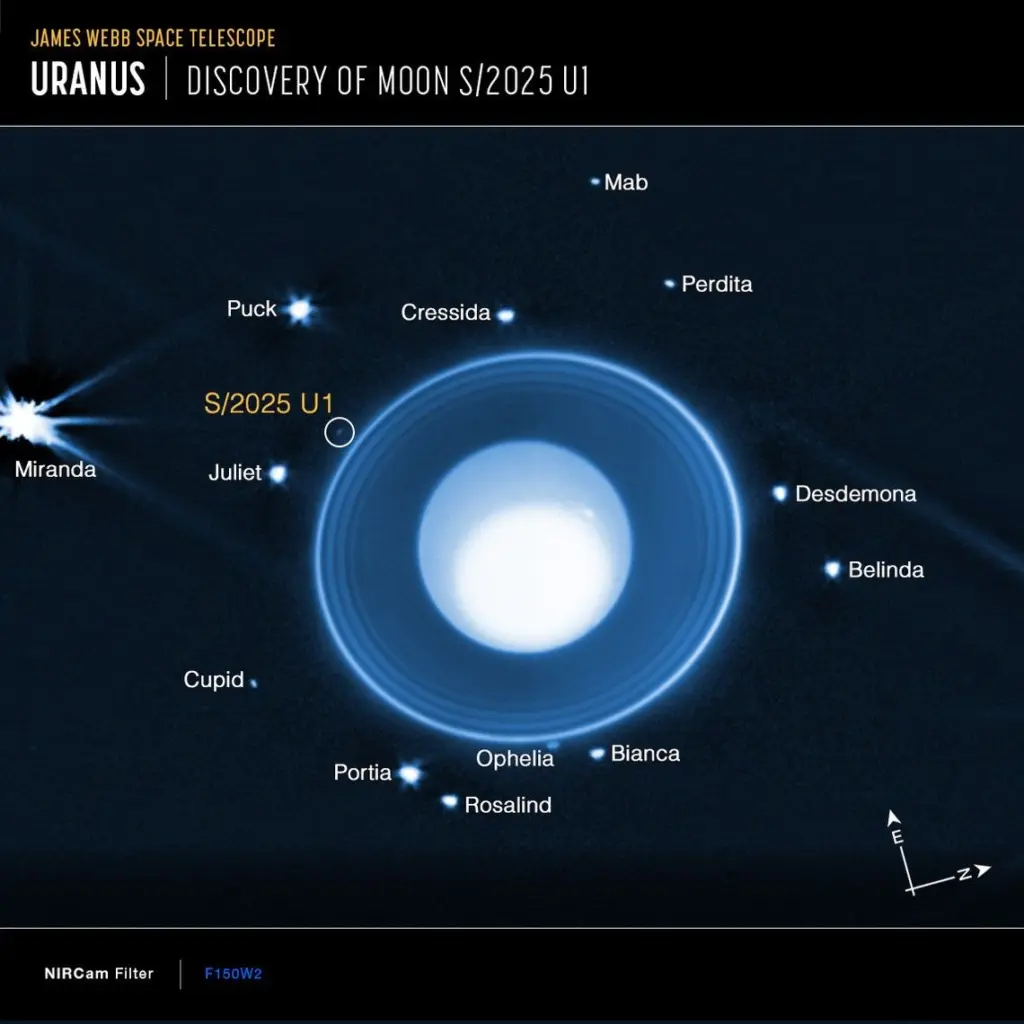NASA’s James Webb Space Telescope (JWST) has uncovered an exciting new member of Uranus’ family of satellites. A team of scientists led by the Southwest Research Institute (SwRI) has identified a previously unknown moon orbiting the ice giant, raising the total number of known Uranian moons to 29. The discovery was made on February 2, 2025, using Webb’s powerful Near-Infrared Camera (NIRCam).
A Hidden Moon Revealed
The new satellite, temporarily designated S/2025 U1, was detected in a series of long-exposure images captured by Webb. The moon’s tiny size (only about six miles (10 kilometers) in diameter) likely explains why it escaped detection by Voyager 2 during its historic Uranus flyby in 1986, as well as by other Earth-based telescopes.
“This is a small moon, but a significant discovery. Even Voyager 2, which gave us our first close-up look at Uranus nearly 40 years ago, missed it.”
said Maryame El Moutamid of SwRI’s Solar System Science and Exploration Division.
Location and Orbit
The newly discovered moon resides about 35,000 miles (56,000 kilometers) from Uranus’ center, orbiting in the planet’s equatorial plane. It sits neatly between the paths of Ophelia, positioned just outside Uranus’ main rings, and Bianca. Its orbit is nearly circular, suggesting that the moon likely formed close to where it now resides.
This makes the moon the 14th known member of Uranus’ complex inner moon system, which interacts dynamically with the planet’s rings. Scientists believe these interactions hint at a turbulent and chaotic history, blurring the distinction between Uranus’ rings and moons.
Expanding Uranus’ Complex System
Unlike any other planet in our solar system, Uranus boasts a particularly rich population of small inner moons. Matthew Tiscareno of the SETI Institute, a member of the discovery team, explained:
“No other planet has as many small inner moons as Uranus. Their complex relationships with the rings suggest an evolutionary story that’s far more chaotic than we once imagined. This newly discovered moon is smaller and fainter than any we’ve seen before—indicating there may still be more surprises waiting.”
All of Uranus’ moons follow a literary naming convention, inspired by characters from Shakespeare and Alexander Pope. The official name for S/2025 U1 will be determined by the International Astronomical Union (IAU).
Building on Voyager’s Legacy
The discovery highlights Webb’s role as a successor to earlier planetary missions. El Moutamid said:
“This shows how astronomy continues to advance, Voyager 2 gave us humanity’s first close-up of Uranus in 1986, and now Webb is pushing that frontier even further.”
The finding was part of Webb’s General Observer program, which allows scientists across the globe to propose investigations using the telescope’s instruments.
NIRCam: The Tool Behind the Discovery
At the heart of this breakthrough is Webb’s Near-Infrared Camera (NIRCam), one of its most powerful instruments. NIRCam is designed to detect faint infrared light, ranging from 0.6 to 5 microns, making it ideal for spotting distant and dim objects in space, such as small moons, exoplanets, and even the earliest galaxies.
For the Uranus observations, NIRCam employed its wide band F150W2 filter, which captures light in the range of 1.0 to 2.4 microns. This wavelength sensitivity allows astronomers to distinguish fine details that are invisible in visible light, including the faint glow of icy satellites.
NIRCam’s strengths include:
| High Resolution Imaging | provides sharp, detailed views that rival the clarity of visible-light telescopes |
| Infrared Sensitivity | reveals celestial objects too faint to be seen with traditional telescopes |
| Time-Lapse Imaging | A new moon was spotted in a six-hour timelapse by Webb |
By combining sensitivity with precision, NIRCam continues to transform planetary science, allowing researchers to see what was once beyond reach. The discovery of S/2025 U1 is just the latest demonstration of its capabilities.

